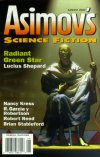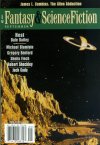Story Selections for October 2000
These reviews by Locus Online editor Mark R. Kelly are adapted from his column to appear in the November 2000 Locus Magazine.
|
|

Lucius Shepard, ''Radiant Green Star''
(Asimov's August 2000)
A novella set in 21st century Vietnam, about 13-year-old Philip, traveling with the eponymous circus, who learns in a dream that his father is scheming to steal his inheritance. The circus owner Vang advises Philip to learn about his father's assets, and beware. Philip falls in love with Vang's niece Tan, learns to throw knives, listens to endless recitations from an aged former American POW about the war, and slowly moves toward an inevitable meeting with his father. The SF elements of the tale -- biochip dreams, virtual heavens, specially trained bodyguards -- may seem incidental because they're so thoroughly woven into the fabric of the story; but they're key to the development and resolution of the story, which is an absorbing psychological mystery marked by hypnotic storytelling and lovely writing.
Also notable in this issue: R. Garcia y Robertson’s “One-Eyed Jacks and Suicide Kings” is absorbing historical SF about a time traveler in medieval France, marked as usual by the author's insights into daily life in the past. Brian Stableford's “The Ladykiller, As Observed from a Safe Distance” is a terrific idea (genetically modified semen that produces an addictive effect in women exposed to it) couched in an unfortunately perfunctory story. And Nancy Kress's "To Cuddle Amy" is a sharp, brief take on the dangers of cloning and America's throw-away culture.
§

James L. Cambias, ''The Alien Abduction''
(F&SF September 2000)
Radical aliens'-rights activitists kidnap a visiting alien from the Carl Sagan Institute for Xenology, convinced NASA is holding it captive, and hole up in an isolated farmhouse. Alternating passages told from the alien's POV express its bewilderment at his captors' arguments that he should not take human marvels back to his planet for fear of ruining his world the way humans have done to “Gaia”. The story doesn't satirize radical arguments so much as it examines radicals' extreme attitude: they are the "dedicated members", the ones in any organization who are fanatics because they have no other lives -- and they’re the ones who do the most damage. Cambias is a new writer who debuted earlier this year in F&SF; his second story is just as thoughtful and exciting, and shows him to be a new writer to watch.
Michael Blumlein, ''Fidelity: A Primer''
(F&SF September 2000)
Lydell, whose wife Judith is pregnant with twin sons, decides to have one of them circumcised and the other not. After the kids are born Judith, taking them to swim class, meets another man, who is trying to save his own marriage by jump-starting his impotence with another woman. And then Lydell changes his mind, deciding his uncut son should be circumcised after all. Blumlein relates these events in an arch manner, with asides about how the characters relate to people he's actually known, and leading to a list of explanations and morals at the story's end. It's playful metafiction, but the human story is compelling nevertheless, and somehow it comes across as especially sincere by knowing the "author's" "real" motivations for telling the story.
Also notable in this issue: Jack Cady's "Jeremiah", about an old-style preacher trying to save the soul of a desolate town on the Washington coast, is strange and unsettling, with characters saying perversely opposite things from what realistic characters in such situations might say. And Dale Bailey's "Heat" is an effective, Bradburyesque fantasy about parents of a World War II soldier coming home; the story keys off a cliche, but Bailey's characters are as quick to catch on as we are.
§
Stephen Baxter, ''Open Loops''
(Skylife, edited by Gregory Benford and George Zebrowski)
One of two original stories in this anthology about space habitats. Scenes set exponentially farther in the future than the last -- 10 years, 100, 1000, etc. -- describe the excavation and colonization of asteroid Ra-Shalom, and its role in solar system culture before the next wave of expansion, outward into the galaxy, begins. (Stages of stability and expansion are characterized by cycles of open and closed loops of mass and energy.) Alternating scenes describe an ancient supernova and a spacecraft fleeing it that eventually reaches our asteroid system. The two strands in this Stapledonian future history come together at the end, in a time travel sleight-of-hand.
Paul J. McAuley, ''Reefs''
(Skylife, edited by Gregory Benford and George Zebrowski)
Roving asteroid habitat Ganapati has found long-lost planetoid Enki, site of an experiment in accelerated evolution 80 years ago. Now Enki's cleft is swarming with enormous space-going organisms, which Ganapati scientists explore via robotic proxies. The real story is the conflict between Ganapati's scientists and their bosses, who are interested in profit and willing to cut off exploration -- even destroy what's left to prevent others from finding it later -- once their profit is assured. The biochemical descriptions are as thick as anything you'd read in any SF magazine, but this is the rare hard SF story that pays as much attention to the not-always-noble motives for exploration as much as their results.
Michael Swanwick, ''The Raggle Taggle Gypsy-O''
(Tales of Old Earth)
The one original story in this Swanwick collection follows a man named Crow and a woman called Annie as they drive a truck with two monsters in the back down twisty mountain roads, fleeing someone named Eric. Soon they're in ancient Rome, selling the creatures for coliseum shows. The story mixes SF and fantasy elements: time travel, complete with a theory of “robust integrity” to explain limitations on changing the past; and mythopoeic ideas about the existence and persistence of archetypes. Crow is such an archetype, his existence made necessary through repetition in songs and stories, and his battle with Lord Eric for Annie leads to a clever application of both the SF and fantasy ideas. This story is reminiscent of Roger Zelazny's work, in the audacious blend of ideas and in its explicit allusions to literature and mythology.
Robert Charles Wilson, ''Ulysses Sees the Moon in the Bedroom Window''
(The Perseids and Other Stories)
There are three original stories in this book, like the others set in Toronto and connected at least peripherally to a bookshop called Finders. "The Fields of Abraham" and "Pearl Baby" are substantial works about the bookshop and people who live there, but this story may be the best of the three, though it's the smallest, and least concerned with the bookshop. "Ulysses" depicts Matthew visiting his college buddy Paul and Paul's wife Leah -- whom Matthew has designs to seduce -- for dinner and cocktails. Paul has bought an odd rock at Finders, and uses the occasion to recall college debates about "higher" beings. Is their cat Ulysses, for example, aware of being surrounded by "higher" beings? This is a more traditionally literary story than most of the others in Wilson’s collection, using characterization and subtle analogies to suggest, more than explicate, its premise.






